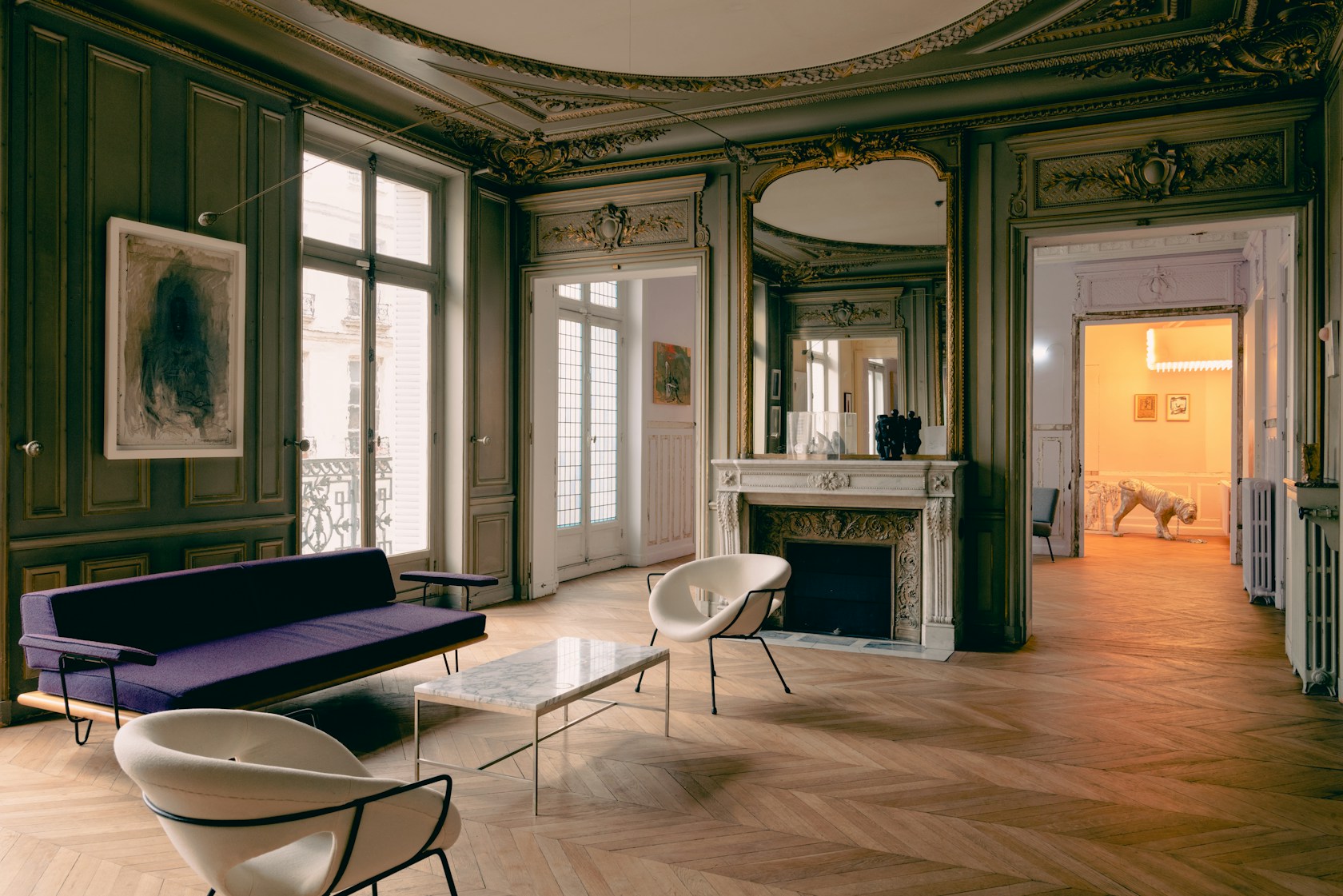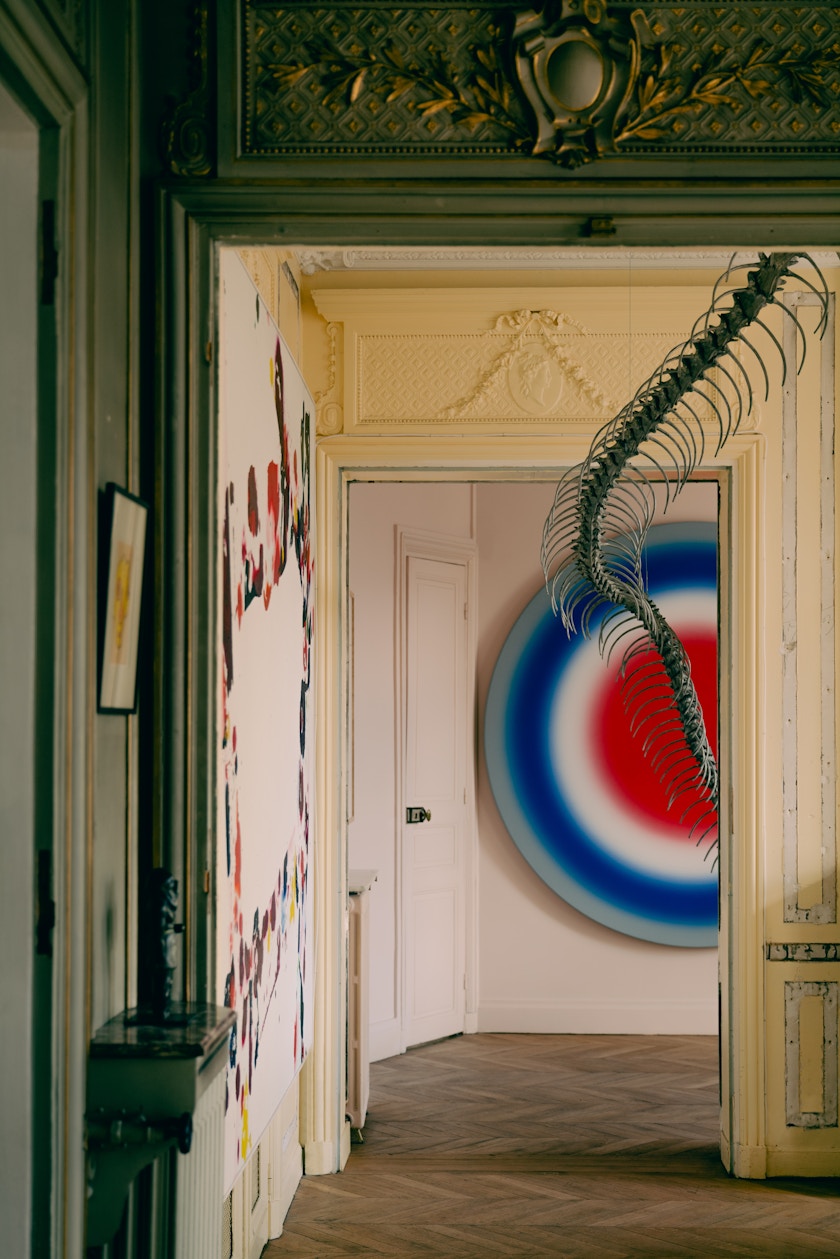
Kamel Mennour in his living room. Situated on the mantel, two plastered sculptures by Douglas Gordon and a 1950s bronze sculpture by Alberto Giacometti encased next to Giacometti's bronze Composition (1927-28). Photo: Alixe Lay.
In his 18th-Century Residence, Kamel Mennour’s Collection Captures the Spirit of Home
Works by Daniel Buren, Ugo Rondinone, and Sam Francis are in conversation with daily life in the gallerist’s Parisian apartment
- By Camille Okhio
- Living With Art
Parisian gallerist Kamel Mennour has always let his intuition guide him, having forged his own path fueled by tenacity and without the trappings of inherited wealth or insider knowledge. Born in Algeria, he relocated to Paris with his mother at the age of two to join his father. He was an avid student from the start, absorbing everything possible at university, funding his studies himself with steady, but uninspiring work. He majored in economics, for which he had an undoubted aptitude, but no true passion. “The only motivation I had after university was to be a gallerist,” says Mennour. “It was insane. Obsessive. I was reading, reading, reading. I wanted to know everything.”
His fascination with art was sparked unexpectedly during a visit to Amsterdam with university friends at the formative age of 20. Interjecting planned gallivanting was a trip to the Rijksmuseum, where Mennour happened upon Rembrandt’s monumental painting The Night Watch (1642). At over four meters wide, the painting overwhelms the senses of any viewer, as it did for Mennour. He describes its scale and setting as transportive, its figures impressively dynamic, and Rembrandt’s use of light and shadow hypnotizing. Its impact was perhaps the starting point for some of Mennour’s later, monumental acquisitions, but back then it served to drive him towards a dedicated career in the arts. “This is a time in your life that you don’t know what to do. You have to imagine,” he says. “You’re excited, but you’re also afraid.”

Kamel Mennour in his home, next to five maskettes from the Dan peoples, Ivory Coast, on the mantel. The architectural enfilade feature creates a view into other rooms, which include a c. 1958 daybed designed by George Nelson (Associates) and produced by Herman Miller, Huang Yong Ping’s Xuan Wu (2002), and Ugo Rondinone’s sechsterfebruarzweitausendundzehn (2010). Photo: Alixe Lay.
Moved by this experience the eager and energized Mennour began sourcing and selling his first works, beginning with photographs found in flea markets sold from door to door. He opened a shoebox of a gallery in 1999 with only enough capital for one employee—himself. More help came with time and eventually a second space was opened large enough to expand his program. Now, 23 years later, Mennour manages four spaces and a team of 47 in Paris, representing the likes of Daniel Buren, Douglas Gordon, Anish Kapoor, and Ugo Rondinone.
“I could have opened a gallery in New York or Hong Kong or Dubai, but I never wanted to,” says Mennour. “For me, it’s very important to preserve your privacy and be connected with your family. I’m always coming back home to my real life.” His wife, whom he met at 22, he describes as his rock and the heart of the home they share with their five children. “What makes a home for me is love and spirit,” says Mennour. “You can have a fantastic house, but without those two things it is cold and dead.” And so Mennour’s obsession extended past enterprise. Every decision he makes includes a dose of intuition, even more so for the purchases that find their way into his personal collection. The pieces with which Mennour lives are constantly rotating, some in storage, many hung at intervals throughout his inviting home.

In the living room, a pair of armchairs by Roger Landault and a daybed designed by George Nelson (Associates) and produced by Herman Miller surround a Paul McCobb table from the 1960s. On the wall hangs a work by Alberto Giacometti, the mantle features two plastered sculptures by Douglas Gordon and a 1950s bronze sculpture by Giacometti encased next to his bronze Composition. Petrit Halilaj's mobile Si Okarina e Runikut is suspended from the ceiling. In the subsequent rooms, a work by Camille Henrot on the left, Huang Yong Ping, Philippe Parreno, and Mattjew Lutz-Kinoy on the right. Photo: Alixe Lay.
Decorating his family’s 18th-century apartment was a process that was kept decidedly close to home. While Mennour has collaborated with prolific interior designers such as Pierre Yovanovitch on several of his Paris galleries, he chose to keep the designing of his home a family affair. “In the gallery, we need to vanish so the artists can deliver. In the house, we needed feng shui and spirit, so in the end we did it ourselves. And luckily, my wife is the best interior designer,” says Mennour.
The apartment sits on a quiet, dreamy block in Paris’s 6th arrondissement. Though older than many residential buildings in the city, its layout and scale seamlessly lent themselves to Mennour’s very modern approach to displaying work. Some of the most imposing pieces in the space were commissioned especially for it, permanently altering its energy and adding to the apartment’s long and rich history. “At the entrance we have an incredible in- situ installation by Daniel Buren,” Mennour says. “It’s an immersive in-situ drawing made of marble and charcoal. It immediately changes your perception of the space when you arrive.” Mennour worked with Buren closely as he created the piece specifically for the home. The intention was to create a work directly in dialogue with the architecture of the apartment. “When you ask an artist to create something for your apartment, even when you are a dealer, it’s really a gift they are giving you,” says Mennour with distinct gratitude in his voice.

Installed in the entrance corridor, Daniel Buren's 2015 (Arabescato T (Italie) / Blanc Thasos (Grèce), a 25-element marble-and-charcoal drawing, and Zineb Sedira's The Battle of Algiers, 1966 by Gillo Pontecorvo. Photo: Alixe Lay.
The gallerist is not one to let a blessing go unappreciated. Constant acknowledgement of the circumstances which have shaped him is a vital ingredient to his success. “When you start from nothing and elevate your life, you want to maintain this good fortune,” he says. “I am conscious of the fragility of it all. You need to feed it for it to continue.” That frank acceptance of reality pervades every aspect of his life and work. The artworks he brings home are reminders of this.
“There are some wonderful installations in the house, but not too many works,” says Mennour. “I wanted peace at home. I’m with art every day, sometimes I want silence in the house.” Each work has space to around it to breathe. Mennour activated a commodious corridor with an installation by the sensitive minimalist artist François Morellet created for a show at the Dia Art Foundation before his death in 2016.

In the antechamber, five maskettes from the Dan peoples, Ivory Coast, and a lantern by Thomas Boog. In the adjecent room, a Martial Raysse gouache from 1963 above a bronze sculpture by Camille Henrot and a work by Daniel Buren on the left. On the right, Alberto Giacometti's painting Dark Head. Photo by: Alixe Lay.
In the dining room, a kaleidoscopic acrylic on canvas work by Sam Francis dominates an entire wall, reflecting the tones of a nearby Ugo Rondinone silkscreen in the adjacent drawing room. Both spaces flow into a living room anchored by a deep purple George Nelson sofa. Scattered throughout the home are more design masterworks, including classics by Florence Knoll, Roger Landault, and George Nakashima, among many others. One massive, circular Pierre Paulin sofa dominates the family room in the center of the home, where Mennour and his wife frequently congregate with their five children. It’s an opportunity to be alone, while with each other: “One of us might be watching a film, another one reading a book, someone is on their laptop, someone else is eating cake,” says Mennour. It’s a home within a home.
Elsewhere in the home, minute sculptures by Camille Henrot, Douglas Gordon, and Alberto Giacometti are displayed on mantelpieces and radiators. Two exceptions in size are playfully imposing works by Huang Yong Ping: one of a dog off its leash and another of a Jurassic skeleton suspended from the ceiling and connecting two rooms.

Looking into the dining room, details of works by Latifa Echakhch and Sam Francis are seen. Huang Yong Ping's 2002 Xuan Wu is suspended from the ceiling. The enfilade looks onto Ping's 2003 installation Amerigo Vespucci below two Matthew Lutz-Kinoy drawings and Philippe Parreno's Marquee. Photo: Alixe Lay.

Seen through the enfilade are a 1939 Gaston Chaissac painting and a bronze sculpture by Camille Henrot, Sam Francis's Untitled N. 22, and a work by Ugo Rondinone from 2010. Xuan Wu by Huang Yong Ping is suspended from the ceiling. Photo: Alixe Lay.
Mennour’s collection functions like a kind of diary, providing a backdrop for and participating actively in the life he has built for himself and his family. “My children were raised in this apartment. Living with art has become normal for them,” says Mennour. “I wanted to create a very specific situation for our daily life.” This was an objective that only could have been achieved through Mennour’s abundance of intuition, consideration, and care. For the gallerist, the drive to collect comes purely from the gut. There is no overt strategy, no explicit rhyme or reason beyond pure, inspired need. Reflecting on the collection and the home he has built, he says confidently, “collecting is something you must do for yourself.”

One of Mennour's mantels displays a Supi (Club) from Malaita Island, Salomon Island, next to Matthew Lutz-Kinoy's Pensive Bird Tile and a wooden tribal statue. To the right of the mirror, Composition by Jean Degottex. Reflected in the mirror, Dialogue by Lee Ufan. Photo: Alixe Lay.
Copyright on works of visual artists affiliated to a CISAC organization has been arranged with Pictoright in Amsterdam. © c/o Pictoright Amsterdam 2023.


